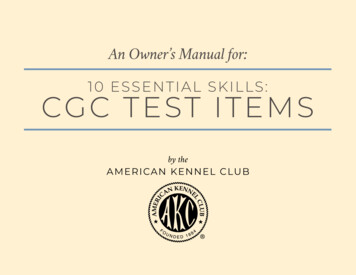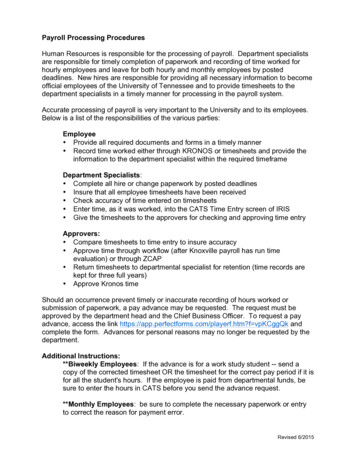
Transcription
University Committee on Animal ResourcesManual on the Responsible Care andUse of Laboratory Animals1
ContentsPreface3Chapter 1. Regulations and Requirements4IACUCAnimal Use CategoriesChapter 2. Biomethodology of Laboratory AnimalsDrug Dosage, anesthesia and analgesiaEuthanasiaHousing: Mouse & Rat Cage DensityEnrichment & Social Housing – RodentsHandling of Common Laboratory AnimalsRodent IdentificationDLAM Mouse Tail Biopsy SOPFluid and Drug AdministrationBlood CollectionGuidelines for Aseptic Recovery Surgery on USDA Regulated SpeciesGuidelines for Aseptic Recovery Surgery on Rodents and BirdsUniversity Policy on Major Invasive Surgery (Ooctye Harvest) on FrogsChapter 3. Alternatives: Replacement, Refinement, Reduction4612131516192225262832343740412
PrefaceThe cornerstone of responsible care and use of laboratory animals in a research facility isan institutional commitment to a strong training and continuing education program. Thedynamic nature of biomedical research requires that we keep abreast of changes inregulations and refinements in research techniques. The University of Rochester ManualOn The Responsible Care And Use of Laboratory Animals guides researchers throughexisting regulations and instructs personnel about humane methods of animalmaintenance and experimentation. The Manual is one part of a multifaceted trainingprogram available to research personnel and animal care technicians at the University ofRochester. Individual training in specific techniques of biomethodology is available forresearchers contemplating a new animal model or developing an experimental technique.A periodic Newsletter and updated pages to the Manual will keep you informed oflegislative trends, aware of animal care and use issues at the University of Rochester, andcurrent with new techniques in laboratory animal research. I look forward to visiting youranimal laboratories and becoming more familiar with your areas of research. Our goal is tocontribute to an environment where the highest quality biomedical research and teachingare possible.Sincerely,Jeff Wyatt D.V.M., M.P.H. ACLAM DiplomateDirector and Chair of Comparative Medicine, University of RochesterUniversity of Rochester Attending Veterinarian3
Chapter 1: Regulations & RequirementsIntroductionScientists working with laboratory animals in research or teaching protocols may find thelong list of acronyms used to describe regulatory, institutional and funding agenciesoverwhelming. The Institutional Animal Care and Use Committee (IACUC), Public HealthService (PHS), United States Department of Agriculture (USDA), and New York StateDepartment of Health (NYSDH) play instrumental roles in laboratory animal care and useat the University of Rochester. The purpose of Chapter 1 is to introduce the organizationsthat promulgate regulations and requirements we must be familiar with to maintain thelicense and privilege to use laboratory animals in biomedical research.Institutional Animal Care and Use Committee (IACUC)The Institutional Animal Care and Use Committee (IACUC) is required by federal law andas a condition of NIH funding. The University of Rochester IACUC is the UniversityCommittee on Animal Resources (UCAR). UCAR must have at least five members,including a veterinarian with program responsibilities, a scientist experienced in laboratoryanimal research, a non-scientist and an individual who has no affiliation with the institutionbesides UCAR membership. The following UCAR functions are mandated by the USDAthrough the Animal Welfare Act regulations or required by the Public Health Service as acondition of NIH funding.1. UCAR reviews proposed research protocols for compliance with USDA Regulationsand PHS Policy and guidelines. The principal investigator submits the"Authorization to Use Animals in Research or Testing" form to UCAR (please referto the forms at http://www.urmc.rochester.edu/ucar/forms/index.cfm and theguidelines for forms submission fm). UCAR may approve orrequire more information or modifications before approval. All animal research andtesting protocols must be prospectively reviewed and approved by UCAR.2. UCAR reviews all approved protocols annually. The UCAR secretary sends theUCAR Annual Protocol Review to the principal investigator for completion beforethe anniversary date of the approval. All protocols must be reviewed and approvedannually. Full protocol review occurs every three years. Any protocol modificationmust be prospectively approved.3. UCAR must inspect, at least once every six months, all of the animal facilities,including animal study areas/satellite facilities, using the USDA Regulations andPHS Guide as basis. UCAR submits a written report of the inspection to theInstitutional Official. The Acting Institutional Official (Dr. Mark Taubman) is theindividual at a research facility who is authorized to legally commit on behalf of theresearch facility that the requirements of the federal regulations are met. UCARsuspends an activity involving animals when necessary; takes corrective action andreports to the funding agency and/or USDA.4. UCAR makes recommendations to the Institutional Official regarding any aspect ofthe research facility's animal program, facilities or personnel training.4
Please contact the UCAR secretary at x5-1693 to schedule a meeting for assistance ormore information.Authorization to Use Animals in Research or TeachingFederal and State statues as well as the Public Health Service Animal Welfare Policyrequire that the University establish an "Institutional Animal Care and Use Committee,"hereafter known as the University Committee on Animal Resources (UCAR). Underregulatory mandates UCAR is charged with the responsibility and authority for oversight ofproper care and use of all laboratory animals. As part of meeting this responsibility, theUniversity requires that all laboratory animal use be reviewed and approved by UCAR.In order to insure that all projects requiring the use of laboratory animals have beenadequately reviewed, according to the specific criteria detailed in the federal regulations,UCAR has adopted the "Animal Use Protocol" FORM. A FORM must be completed,reviewed and approved prior to placing an order for animals.The FORM must be submitted and signed by a Faculty Member of the University ofRochester as the Principal Investigator (P.I.). Non-faculty members, e.g. post-doctoralfellows, graduate students, etc. may be named as Co-PI.The primary purpose of the UCAR review is to be sure that animal welfare concerns havebeen adequately considered. This usually occurs prior to review of the scientific merit ofthe grant application by external funding agencies. The Public Health Service (PHS),including NIH, allows for up to 60-days after grant deadline for this approval to be given.Care should be taken when filling out this FORM to assure completeness and accuracy.The FORM must be typed. Please refer to the Guidelines within the form and the"Extended Help" to assist in completion of this form. UCAR recognizes that research iscreative and dynamic, however, during the course of a project, significant variances mustbe justified and described in writing to UCAR and prospectively approved by UCAR.According to federal mandate, approvals may only be given for one year. For annualrenewals, a short questionnaire must be completed and filed with the UCAR if nosignificant change in the protocol or personnel has occurred. A new application, reviewand approval by UCAR is required every three years whether or not significant changeshave been made.Please answer all questions on the FORM. Do not attach a grant application or referenceit. Do not reference a previously approved protocol or part of a protocol or procedure thathas been previously approved. Do not refer to other pages in the FORM or grant proposalitself.For assistance in completing the FORM, please contact the UCAR Executive Secretary,x5-1693 between the hours of 7:30 AM and 4:00 PM.5
Guidelines to Use During Completion of Animal Care and Use FormsWEB-Based Submission of Animal Protocols – Animal Use Protocols must be submittedonline using Topaz Enterprise – beginning January 1, 2010, all new submissions of animalprotocols and all 36-month reviews must be submitted in this format. UCAR has beenaccepting submissions on this system for about six months. The Topaz System can beaccessed by web browsers (Internet Explorer, Firefox, Safari) from either a Mac or PC.TOPAZ training is mandatory – all faculty and staff must attend a TOPAZ training sessionand obtain an account. New faculty members who are transferring to the University mustalso submit protocols online (individual training can be arranged via telephone ifnecessary). If a PI wishes to have a lab manager or administrative staff member givenprivileges to create and edit, or modify an on-line protocol, they must also attend a trainingsession. Accounts are set up in conjunction with training sessions.If you have any questions about this or want to schedule TOPAZ training, contact JeanDefendorf in the UCAR office (x5-1693).Animal Use Categories, Definitions, and ExamplesCategory C:Animals that will not experience pain, discomfort, or distress. Euthanasia using AVMA approved methods (including general anesthesia followedimmediately by cervical dislocation or decapitation) for purposes of harvestingtissue, with or without fixation, in-situ. Behavioral observations. Natural breeding. Venipuncture for blood collection. Routine injections of non-toxic substances by IV, IP, SubQ, ID or IM routes. Genotyping using tail-snip without anesthesia (using the vivarium SOP) inpreweanling mice only. Identification by ear punch or toe clip without anesthesia (using the vivarium SOP)in preweanling mice only. Tube feeding or gavage. Studies which use positive reinforcement or scheduled feeding or watering. Use of aversive stimuli that are mild, of limited duration, and can be avoided by theanimal. Cervical dislocation or decapitation without the use of sedative, anesthetic ortranquilizing drugs as described in AVMA Guidelines on Euthanasia. Provideevidence that this method of euthanasia is scientifically justified, and that it will bedone by specifically trained personnel using appropriate techniques and equipment.Category D:Animals that may experience pain, discomfort or distress but will be administeredappropriate anesthetic, analgesic or tranquilizing drug to alleviate these effects. All major or minor recovery surgery.Procedures for which anesthesia or sedation is used, except euthanasia describedin C above.6
Implantation of mini-osmotic pumps.Retrobulbar blood collection and intraocular injections under sedation, using DLAMprocedures.Non-recovery surgical experiments (i.e. assessing organ function followed byeuthanasia).Category E*:Animals will experience pain, discomfort or distress for which anesthetics, analgesics ortranquilizing drugs would customarily be given but will not be administered because theiruse would adversely affect the interpretation of experimental results or interpretation. Tumor studies or monoclonal antibody production in which animals will experiencepain not alleviated by analgesics.Tumor studies in which subjects exceed standard UCAR "end-points."Retrobulbar blood collection without sedation. Provide evidence that this procedureis scientifically justified and that it will be done by specifically trained personnelusing appropriate technique.Exposure to radiation that produces clinical illness.Use of aversive stimuli that are unavoidable, such as inescapable electric shock orexposure to environmental extremes.Death as an endpoint.*Note: Federal regulations require that experiments conducted that are in this categorymust be specifically reported in the University's Annual Report to the United StatesDepartment of Agriculture. The Report must include the species, numbers and briefexplanation of the scientific justification.United States Department of Agriculture (USDA)The United States Department of Agriculture (USDA) is a federal agency that promulgatesand enforces federal regulations. The federal law is the Animal Welfare Act (Public Law89-544) and amendments. A copy of the Animal Welfare Regulations is available forreview in the UCAR office at x5-1693. The federal regulations define standards for thehumane handling, care, treatment and transportation of dogs, cats, guinea pigs, hamsters,rabbits, nonhuman primates, and farm animals used in biomedical research or teaching.Nonregulated animals include laboratory bred species of rats (Rattus sp. ) and mice (Mussp. ), poultry, birds, reptiles, amphibians and fish. The USDA requires that all researchfacilities be registered and report regulated animal use annually. The USDA reporting yearis from October 1 through September 30. The annual reporting is required only forregulated animals (e.g., dogs, cats, rabbits, swine, sheep, goats, hamsters, guinea pigs,cotton rats, nonhuman primates, wild caught mammals).USDA Animal Plant and Health Inspection Service (APHIS) veterinarians makeunannounced inspections of research facilities. The inspector evaluates all aspects of theresearch facility's program for compliance with standards of the federal regulations. Theinspector reviews protocols in the IACUC office, observes animals in the animal rooms andvisits laboratories where animals are transported. Any items of noncompliance with theregulations are documented on the inspector's report and become available to the public7
through the Freedom of Information Act. Serious items of noncompliance may place theresearch facility on probation or result in suspension of all regulated animal researchactivity. Please become familiar with the federal regulations. Please call theUCAR.secretary at x5-1693 to make an appointment with a UCAR member to gain moreinformation on how the USDA Regulations impact your research.USDA Animal and Plant Health Inspection Services (APHIS) GuidelinesInstitutional Animal Care and Use Committee (IACUC) GuidelinesNote: These guidelines are not meant to replace the Animal Welfare Act (AWA),regulations or standards.1. Membership of IACUC: 2.31 (a)(b) and 2.33 (a)(3) 3 members appointed by CEO. Includes at least one nonaffiliated person,one veterinarian, and a chair.2. Program Review and Facility Inspection: 2.31 (c)(1) and (c)(2) At least once every 6 months by at least two IACUC members3. Program Review and Facility Inspection Reports: 2.31 (c)(3) IACUC majority reviews, signs and submits to Institutional Official. Contains minority view. Identifies departures from regulations or standards and reasons. Distinguishes significant from minor deficiencies. Provides reasonable and specific plan and schedule and reasons. Nonadherence to plan of correction for significant deficiencies reported within15 business days to APHIS and any Federal funding agency.4. Review/Investigate Complaints About Animal Care: 2.31 (c)(4) Complaints may be from the public or from facility personnel [refer also to2.32 (c)(4)].5. Recommendations Concerning Animal Care Program: 2.31 (c)(5) To Institutional Official about animal care and use program, facilities, orpersonnel training.6. Review of Protocols: 2.31 (c)(6) and 2.31 (d)(1-5) and (e) Review of ongoing protocols no less than once a year. All IACUC members given list of proposed protocols prior to review. Full committee (quorum) can be convened at request of one member. IACUC reviewer must have no conflict of interest with protocol. May use nonvoting consultants. No study is to begin before IACUC review and approval.7. Review Significant Changes to Approved Protocol: 2.31 (c)(7) and (d)(8), 2.31(e) IACUC must preapprove significant changes to protocol.8. Authorization to Suspend a Protocol: 2.31 (c)(8) and (d)(6), 2.32 (d)(7)8
IACUC can suspend approved protocol with majority vote of convenedquorum.Report suspensions to APHIS and any Federal funding agency.9. Field Study Exemption From Protocol and Faculty Review: 2.31 (c)(2) and(d)(1) Part 1 defines a field study as using free-living wild animals in a naturalhabitat without invasive procedures, harm or altering of behavior.10. Assurances and/or Statements Required in Written Protocols: 2.31 (d)(1) and(e). All Proposed Animal Activities Procedure does not unnecessarily duplicate previous experiments. Animals' living conditions are appropriate. Medical care is available for the animals. (also 2.33) Qualified and trained personnel are involved with procedures. (also 2.32) Discomfort, distress and pain are minimized. If used in two major surgeries, animal is not allowed to recover (unlessjustified). Description of preoperative and postoperative care. Survival surgery is conducted aseptically in dedicated facilities. Rationale for species and number of animals. Rationale for using animals. Complete description of proposed use of the animals. Complete description of procedures designed to assure that discomfort andpain are minimized. Complete description of method of euthanasia.All Proposed Animal Activities With Potentially Painful Procedures 2.31(d)(1)(i-iv) Discomfort, distress and pain are minimized. Method used, alternative information sources searched with a written list ofparameters used for the search. Procedure does not unnecessarily duplicate previous experiments. Use of proper drugs for relief of pain/distress. No paralytics withoutanesthesia. Attending veterinarian is involved in planning. (also 2.33)11. IACUC Records: 2.35 (a)(1-3) Minutes, proposed activities or significant changes, approvals ordisapprovals of protocols, and semiannual reports with recommendations.12. Exceptions to Regulations and Standards: 2.36 (b)(3) IACUC-approved exceptions to regulations and standards attached to annualreport (APHIS Form 7023).The U.S. Department of Agriculture (USDA) prohibits discrimination in its programs on thebasis of race, color, national origin, sex, religion, age, disability, political beliefs, andmarital or familial status. (Not all prohibited bases apply to all programs.) Persons withdisabilities who require alternative means for communication of program information9
(braille, large print, audiotape, ect.) should contact the USDA Office of Communications at(202) 720-5881 (voice) or (202) 720-7808 (TDD).To file a complaint, write Secretary of Agriculture, U.S. Department of Agriculture,Washington, DC 20250, or call (202) 720-7327 (voice) or (202) 720-1127 (TDD). USDA isan equal employment opportunity employer.New York State Department of Health (NYSDH)Animal research facilities must be licensed by the New York State Department of Health.The license is renewed annually. The New York State Department of Health Inspectormakes unannounced visits and evaluates the care and use of all live vertebrate animalsused or intended for use in biomedical research, teaching or testing. The State Inspectorexamines the animal care and research program and facility for compliance with the USDARegulations, State Regulations and the PHS Policy on the Humane Care and Use ofLaboratory Animals and Guide for the Care and Use of Laboratory Animals. The StateInspector may visit the animal rooms, inspect the researcher's lab and review UCARprotocols. Any deficiencies are stated with deadline for correction in a written report.Serious deficiencies may result in revocation of the facility's license and suspension ofanimal research activity.Public Health Service (PHS)The Public Health Service (PHS) is a federal agency that includes the National Institutes ofHealth (NIH). NIH is a funding agency that supports research activities at qualifiedinstitutions. An investigator qualifies for NIH funding only if there is an institutionalAssurance on file with the Office of Laboratory Animal Welfare (OLAW). The Assurancedescribes how PHS funded animal activities are performed in compliance with the PHSPolicy on Humane Care and Use of Laboratory Animals and the PHS Guide for the Careand Use of Laboratory Animals (Guide). The PHS Policy and Guide state principles of careand use of any vertebrate animal in a PHS funded study. The letter of Assurancedescribes the Institutional Program for the Care and Use of Animals and the InstitutionalAnimal Care and Use Committee. The Institutional Program for the Care and Use ofAnimals includes lines of authority for administering the program and the authority,qualifications and responsibility of the attending veterinarian. A description of the trainingprogram available to scientists, research technicians and animal care technicians is alsorequired. The PHS Policy and Guide are used as basis for the program formation anddescription. The PHS Guide states requirements and recommendations for institutionalpolicies for personnel qualifications, occupational health, aseptic surgery, laboratoryanimal husbandry, veterinary care, and the physical plant. The assurance is updatedannually and considered for renewal every five years. Investigators and staff areencouraged to be familiar with all aspects of the written Assurance. Please read therequest from OLAW. The Assurance, the Guide and the PHS Policy are available forreview in the UCAR office (x5-1693). Please call the UCAR secretary to schedule ameeting with a UCAR member for more information about PHS conditions of fundingprotocols.10
OLAW ReportsJanuary 11, 1994Subject: Internal Distribution of Your Animal Welfare AssuranceDear Colleague:This letter is being forwarded to Institutional Officials and Institutional Animal Care and UseCommittee (IACUC) Chairs throughout the country. Its purpose is to convey arecommendation to all institutions conducting animal-related activities supported by theU.S. Public Health Service (PHS).The Animal Welfare Assurance (Assurance) represents a legally binding institutionalcommitment to the PHS, necessary for eligibility to receive PHS support. Because of itsfundamental importance to that relationship, and because it outlines the mechanisms forimplementation of the PHS Policy on Humane Care and Use of Laboratory Animals(Policy) at the institution, the Office for Protection from Research Risks (OPRR) believesthat the core contents of the Assurance should be generally known by all interested partiesat the institution. Although IACUC members usually have some knowledge of thedocument, OPRR has encountered situations where individual members had not actuallyseen it. More frequently, many investigators and their staffs have expressed a completelack of awareness of the document.When assessing the compliance with the PHS Policy by awardee institutions, e.g., duringsite visits, one of the principal standards against which institutional performance ismeasured is the extent to which the Assurance is adequate and accurate. In other words,does the Assurance conform with the basic requirements of the PHS Policy and is it andaccurate description of the actual practices of the institution? These same questionsshould always be addressed by the IACUC during the semiannual review of programs andfacilities. Major discrepancies between described and actual practices have been the basisfor a number of adverse findings and actions by OPRR.Therefore, OPRR recommends that the institution make the core contents of theirAssurance widely available within the institution for the information purposes and as aneducational tool, not only for IACUC members, but also for animal care staff, investigators,administrators, and other interested parties.Thank you for your attention to this important matter. Please contact the professional staffof the division of Animal Welfare, OPRR (301/496-7163), if you have any questionsconcerning this or any other PHS Policy matter.Sincerely,Gary B Ellis, Ph.D.Director, Office for the Protectionfrom Research RisksNelson L. Garnett, D.M.V.Director, Division of AnimalWelfare, OPRRNational Institutes of Health, Building 31, Room 5B63, 9000 Rockville Pike, Bethesda, MD 2089211
Chapter 2: Biomethodology of Laboratory AnimalsAnesthesiaPain: Recognition of pain depends upon intact pathways from pain receptors to thethalamus and cerebral cortex, as well as functional cerebral cortex and subcorticalstructures. Thus any means that renders the cerebral cortex nonfunctional, such ashypoxia or drug depression, prevents pain. When this happens, stimuli that evoke motornerve reflexes that may be painful to the conscious animal are not painful in theunconscious animal. Equally painful stimuli administered to animals chemically paralyzedby curare or succinylcholine will not evoke a motor reflex simply because of paralysis, butwill cause pain because of the conscious state. Hence, it is possible that unconsciousanimals may feel no pain but respond to certain stimuli, and paralyzed animals may feelpain but cannot respond. Thus, movement is not a reliable indicator of pain, and paralyzingagents (i.e., succinylcholine and curare) are strictly prohibited as euthanatizing agents.The methods used for prevention or relief of pain and distress in scientific experimentationwith living animals will be dependent upon the kind of procedures used on the animals.Selection of an appropriate anesthetic, analgesic, or tranquilizer require the assistance ofan experienced professional.Anesthesia:The definition is the local or general loss of sensation. General anesthesia is achieved bydepressing the brain receptors of pain, thus producing a general anesthetic effect,although not necessarily blocking local responses such as spinal cord reflex arcs.Therefore, it is possible to have good levels of general anesthesia but still have motorreflexes such as pinch-pad and corneal reflexes present. These should not be mistaken forpurposeful responses to pain. They can however, be abolished by deepening the level ofanesthesia. Great care must be exerted when general anesthesia is made too deep sincenot only are pain receptors depressed, but also the vital centers of the brain and brainstem including respiratory, cardiac, hypothalamic, etc. When depressed for too long, heartand respiratory function cease and death ensues unless heroic measures are taken--ifthey are available.Regardless of the species involved, some principles of general anesthesia are universaland worth keeping in mind. They include:A. Maintain patent airway. This is essential if trouble arises and the subject is tosurvive. Nothing must block the ability to breathe freely and easily. With smallrodents that are obligate nose breathers, a patent airway is easily maintained if thenostrils are not blocked.B. Avoid hypothermia. Core body temperature can fall alarmingly, particularly insmall animals, during the course of prolonged general anesthesia. Hypothermiaadded to other factors can produce an irreversible sequence of events leading todeath. Thermostatically controlled heating pads should always be used in animalsurgery.C. Administer anesthetic to effect. Technically, because of wide variation within andbetween species, there is no such thing as predetermined anesthetic dose of adrug. General anesthesia must be given to effect, as measured by physiological12
parameters and response to stimuli. Most anesthetic deaths can be attributed to notfollowing this principle. This is especially true for parenterally administered drugssuch as barbiturates. Once they are injected, there is little the anesthetist can do tocontrol the outcome; therefore, great care is necessary when administering thesedrugs. Most methods of general anesthesia as listed in Table 1 are generally safeand reliable if properly administered and monitored.Drug Dosage – Anesthesia and Analgesia - Please review to the Sedation/Tranquilization,Anesthesia and Analgesia in Laboratory Animals and Veterinarian-Recommended Formularies or contact aDLAM veterinarian (X5-2653).Criteria for the Administration of Analgesics in Laboratory AnimalsRODENT ANALGESIA .pain in rodents may be identified by observing the animal'sreluctance to move about, eat or drink, weight loss, salivation, hunched posture,piloerection, respiratory sounds (chattering in mice) and by vocalization with handling.GUINEA PIG AND CHINCHILLAS.pain in guinea pigs and chinchillas may be identifiedby observing the animal's reluctance to move, vocalization with handling, decreased foodand water intake and postural abnormalities.FERRET ANALGESIA.pain in ferrets may be identified by observing the animal'sreluctance to move, spontaneous vocalization or vocalization upon handling, reluctance toeat and drink, avoidance behavior, depression, postural abnormalities, increasedrespiratory rate and abnormal pattern.RABBIT ANALGESIA.pain in rabbits may be identified by observing the animal'sreluctance to move about, eat or drink, postural abnormalities, increased respiratory rateand/or abnormal pattern and by vocalization with handling.NONHUMAN PRIMATE ANALGESIA.pain in nonhuman primates may be identified bydepression, guarding of painful part, avoidance behavior, spontaneous vocalization orvocalization upon handling, teeth grinding, lying down and getting up repeatedly, abnormalposture, increased respiratory rate and abnormal pattern, reluctance to move orinappetence.CANINE ANALGESIA.pain in dogs may be identified by depression, guarding of painfulpart, spontaneous vocalization upon handling, avoidance behavior, recumbency,inappetence, muscle tremors, attraction to painful area (licking, biting, scratching), andabnormal posture.SWINE ANALGESIA.pain in pigs may be identified by depression, recumbency,vocalization when painful area is manipulated or spontaneous vocalization (e.g. grunting),abnormal posture, inappetence, increased respiratory rate and abnormal pattern, lyingdown and getting up repeatedly and avoidance behavior.SHEEP/GOATS.pain in sheep and goats may be identified by depression, recumbency,vocalization when pai
Department of Health (NYSDH) play instrumental roles in laboratory animal care and use at the University of Rochester. The purpose of Chapter 1 is to introduce the organizations that promulgate regulations and requirements we must be familiar with to maintain the license and privilege to use laboratory animals in biomedical research.










